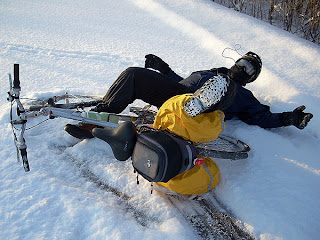"Your not riding your bike in this are you? How do you do it?" Someone will asking when the weather turned cold and snowy.
I smile and tell them, "I am riding in this, and I will be riding all winter and when I can't ride, I will walk." I smile.
But truth be told- they can.
Winter cycling to me is the most fun. The extreme, often unpredictable weather, adverse road conditions, and lack of day light, make it an adventure.
I think having a positive attitude is a big part of it as well.
Here are some things I do to make my rides and commutes safe and fun.
BE Prepared:
I am always prepared for changing weather. I carry extra clothing-shirt, gloves, neck gaiter, socks, hat, helmet cover, pants, and whatever else I may need.
Temperature drops of 30+ degrees are common in winter.
Bike prep:
My bike is well prepared for winter. I have fenders, rear rack, and multiple lights.
Actually, three lights in the front an three in the rear. May seem excessive, but it is not, being visible is very important with the low light conditions of winter. Reflectors and reflective clothing are OK, but nothing catches the eye of a driver like a blinking light. And if you can, don't go cheap on a light- it can save your life!
Lubrication-I use a generous amount of oil on my chain, gears, and derailleurs. The salts and sand are very harsh on the bike.
Obeying the laws:
One should ALWAYS obey the laws of the road. If you have a driver's license you know you know the laws.
Winter is a time for me to be hyper aware of my surroundings. I know the road conditions, what is in front, behind, and on my sides 100% of the time. I am also aware of options to get off the street-especially in icy conditions.
One great strategy to have, all year round, is to assume you are invisible. Too many times people are distracted, and if they are un-use to seeing cyclist, they may not be looking for you and may not see you!
Biking skills in winter: 'What if you slip on ice or snow?" I think one of the best ways for a cyclist to prepare for the adverse road conditions is by learning how to bike on dirt and gravel trails with multiple terrains. Like mountain biking, winter road cycling has its share of obstacles: sticks, leaves, walnuts, sand, ices, snow drifts, branches, slush, mud, just to name a few. Mountain biking prepares you in that you learn how to go over and through obstacles like these. Tires are not as important as you might think, it is more about the pressure in the tire so experimenting with different tire pressures can help insure a safer ride. Studded snow tires are an option, but I have never felt the need for them....yet. Peter White offers an excellent article about studded bicycle tires at Peter White Cycles
Clothing:
Why ride in winter? Why not ride in winter?!
Layering, layering, layering! That is the key, there is no magic one piece of clothing, and in most cases less is more. For instance in winter I usually wear, in temps of 20f to 35f, skull cap, helmet rain cover, neck gaiter, fleece gloves, two light weight wick able long sleeve shirts, a light weight wind breaker with a back vent, cycling shorts, wind pants, or micro fleece pants, wool socks, hiking boots ( I use platform pedals).
Pedals:
I went to platform pedals four years ago and have not looked back! They are easier to use and less
hassle than their clip-less cousins. If you race, you should stick with clip-less. For commuters, in winter, going platform is a better option as use are not clipped in and you can where your winter boots. Better to be able to get your feet down if you hit some black ice.
Our friends at Rivendell Bicycle Works wrote a great article on the benefits of use platform pedals called "the Shoes Ruse". I use platform pedals on all my bikes and all year round, including my long distant tours of hundreds and thousands of miles, much on gravel roads.
In mild dry cold weather I now prefer wearing wool is possible: trousers, underwear, socks, sweat, shirt, hat, gloves, neck gaiter, with a good tough boot. When wet, the one piece of high tech clothing is my Transit Jacket from Showers Pass it is hard to beat for functionality, made by cyclists, for cyclists. A little pricey at $160US, but considering the benefits, well worth it. Also great for Walking, hiking, snow shoeing, cross country skiing, running, anything outside in winter. The Adventure Cycling Association has some great gear options for you
SWEATING?
I regulate my temperature buy the zipper on my jacket, and on my level of exertion. All this takes practice and what works for one person, may be different for another, so be patient. The only rule is: to go ride and experience it for yourself!
EXTREMES?
I have biked in blizzards, sleet, 31f degree rain, snow storms, when temps were well below zero, and all I have to say is: it is FUN...AS LONG AS YOU ARE PREPARED!
So give winter cycling for transportation a try! Here are some resources that may help.
http://www.adventurecycling.org/features/howto.cfm
http://www.icebike.org/
Happy Cycling and stay warm,
Bill
(All pictures were found online if you are the taker, let me know.)









Congratulations for your site. I like very much. Happy New Year!
ReplyDeletethanks for site it looks good
ReplyDeleteSo nice this article.
ReplyDelete